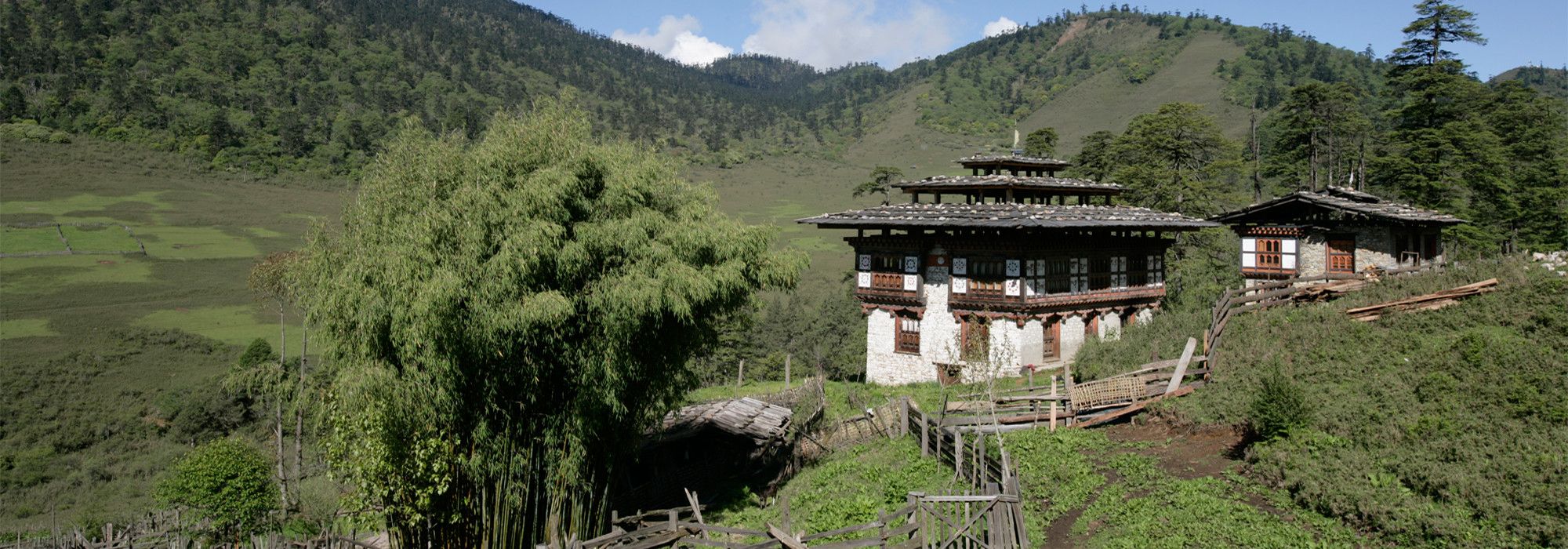
Rigsum Goenpa
Overview
Lama Tshering Gyamtsho from Punakha Dratshang1 who lived during the 18th century was a close disciple of the 9th Je Khenpo, Shacha Rinchen. He was destined to explore the sacred places of Guru Rinpochhe. In his quest, he reached a place called Pemaling located towards the north of Trashi Yangtse in eastern Bhutan. There he found a cave with clear body prints of
Rigsum Gonpo (Jampalyang, Channa Dorji and Chenrizig). A powerful local deity called Genyen Phanbu was the guardian of this sacred cave. The Lama befriended the local deity through his spiritual powers and built a small lhakhang for his meditation. After the death of Lama Tshering Gyamtsho, his nephew and spiritual heir Lama Jangchub Gyeltshen took over the entire responsibility of the cave and the lhakhang. He renovated and extended the present-day lower lhakhang with unique mural paintings of the life history of Lord Buddha (Paksam Thrishing) which can still be seen. The lhakhang was named as Rigsum Goenpa Lhakhang. Lama Jangchub Gyeltshen was instrumental in spreading Buddhism in the region until his soul transcended into the Nirvana. He had already found his spiritual heir in the person of Lama Ngawang Loday, his beloved nephew. His Holiness Yonten Thaye, the 13th Je Khenpo (1771-1775), who was on his way to Tsari
Rongkor (Mountain Pilgrimage) in Arunachal Pradesh, India visited the region and ordained him as the 3rd abbot of Rigsum Goenpa Lhakhang. He was a famous lama who left behind a great spiritual legacy. He constructed the bigger lhakhang and installed valuable ku sung Thukten (sacred artifacts representing the body, mind and speech of the Buddha) including the statue of Jowo Shakya Muni, hundred volumes of Kanjur and the eight enlightening stupas of Lord Buddha (Desheg Choeten Gyed) for the well being of the people of Bhutan. The statue of Jowo was brought all the way from Punakha Dzong. It was made by the famous craftsmen and iconographer Pentsa Dev from Nepal during the reign of 4th Desi Gyalse Tenzin Rabgay. So sacred is the statue that the fifth abbot of the lhakhang, Lama Shacha Gyalpo is believed to have witnessed it speaks. Hence, the name Jowo Soong Joem – the Jowo that spoke. Major reconstruction works at Rigsum Goenpa Lhakhang are under progress. The works which were initiated by the dzongkhag administration and the people and sponsored
by the Royal Government of Bhutan are expected to be over by the end of 2002. Lama Ngawang Loday wished to construct a replica of the Bodhnath stupa of Nepal in Kholong chhu7 valley in memory of his late Uncle Lama Jangchub Gyeltshen and to subdue a demon dwelling at the site where the chorten was to be constructed. Guru Rinpochhe and his brothers8 had constructed the Bodhnath stupa popularly known as Jarung Khashor in their previous lives. Lama Ngawang Loday and his friend Lama Zangpo from Tawang, Arunachal Pradesh set on a journey to Bodhnath. Both returned home with a model of the chorten which was quickly made out of radish. They were determined to construct similar chorten in Trashi Yangtse and Tawang. A Brief History of Rigsum Goenpo Lhakhang and Choeten Kora 3 Consequently, Lama Zangpo constructed one at Pangchanang valley in Tawang, which is known as Gorzam Choeten today. Lama Ngawang Loday constructed another in Trashi Yangtse valley and was called Dueron. Choeten. It later came to be known more popularly as Choeten Kora. By the time they arrived home, the radish model had shrunk distorting the shape. As a result, the choeten particularly the one at Trashi Yangtse underwent some changes in design especially in the level of galleries. The construction of Choeten Kora took 12 long years. It was supported by disciples of Lama Ngawang Loday and devotees from Trashi Yangtse, Trashigang and Kurtoe valley, and also by people from the neighboring tribal communities of Tawang. His Holiness Je Yonten Thaye made his second visit to the valley, consecrated the chorten by making offering of the mandala of Dechhog Paochigpa, and blessed the people in the valley. After the construction, the demon that harmed the people was subdued and banished. Thereafter, it is said that the people in the valley
continued to live in peace and harmony. The pinnacle of Choeten Kora was originally carved out of a huge stone. Later, Lama Shacha Gyalpo, who was originally from Seola Goenpa, Punakha, known as the most learned and
wealthy of Rigsum Lama replaced it with a gilded cupola. It is said that the people who were involved in the work could not think of a way to bring down the stone pinnacle. So, Lama Shacha Gyalpo performed prayers during the day and it is believed that the stone miraculously descended itself at night. It is still found beside the chorten. Pilgrims and devotees who circumambulate the chorten also go round the pinnacle. Another legend says that while the construction of the chorten reached its dome, a girl of eight years old believed to be an angel, who came from Tawang and volunteered to enter the dome and be buried there. On account of
this incident, the 15th day of the first month of the lunar calendar is called Journal of Bhutan Studies 4 Dakpa Kora or circumambulation by the Dakpa from Tawang and the 30th day is called the Drukpa Kora, circumambulation by the Bhutanese. The festivals are held every year and hundreds of devotees from far and near congregate at the chorten. They believe that making prostrations and praying with pure mind at the festivals would enable them to realize their aspirations in life. The sertog or the golden cupola was gilded again through the initiation of the Dzongkhag Tshechu Tshogpa in 1999. The initiative was strongly supported by the Royal Government. Stone-slab roofing of enclosure of the chorten and prayer wheels were restored in 2000-2001 by the dzongkhag administration.
